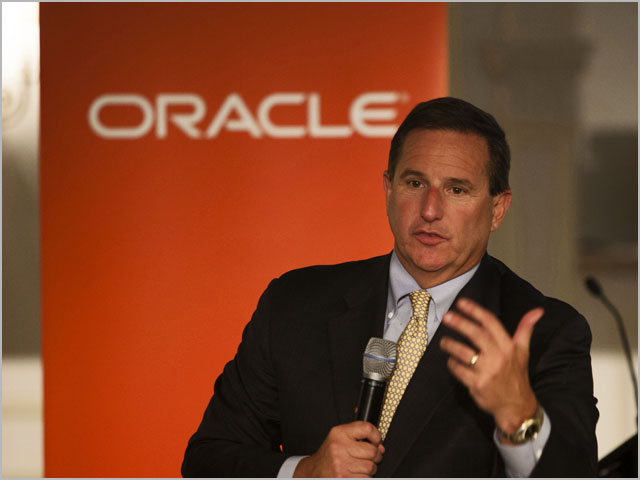 NEWS
NEWS
 NEWS
NEWS
 NEWS
NEWS
Oracle Corp. today showed more progress in battling back from a late start in cloud computing as revenues from those services rocketed higher, but they failed to help it meet quarterly earnings expectations.
Thanks to the drag of slowing revenues of licenses for its core database software market, the Redwood Shores, CA-based business software giant reported its fiscal first-quarter revenues rose just 1.7 percent from a year ago, to $8.6 billion, slightly lower than analysts’ expectations. The company’s profits rose to $1.83 billion, or 43 cents a share, from $1.75 billion, or 40 cents per share, a year ago.
On the more commonly followed profits before certain costs such as stock compensation, Oracle earned 55 cents, shy of the 58 cents analysts had forecast. Oracle said the profit would have been higher but for three reasons: a penny from a higher tax rate from more cloud sales in the U.S, half a penny because of borrowing costs, and another penny from a stronger U.S. dollar.
But it was clear that license revenues from traditional software weighed on results. Revenues from new on-premises software licenses fell 11 percent from a year ago. And Oracle’s hardware business did even worse, as sales of servers and storage devices plummeted 19 percent.
In trading after the market close, Oracle’s shares were falling nearly 3 percent. That followed a 1.5 percent rise in today’s trading, to $40.86. The company’s shares are up about 11 percent so far this year.
Revenues from cloud software as a service (SaaS), or software delivered over the Web, and platform as a service (PaaS), which enables the creation of Web software, jumped 77 percent in U.S. dollars, or 79 percent in constant currency, to $798 million. Total cloud revenues, including infrastructure as a Service (IaaS) such as that provided by leader Amazon Web Services (AWS) and Microsoft Azure, rose 59 percent in U.S. dollars and 61 percent in constant currency, to $969 million. A category Oracle calls “cloud plus on-premise software revenues” hit $6.8 billion, up 5 percent in U.S. dollars and 6 percent in constant currency.
“We overachieved again in the cloud, especially in the United States,” Oracle co-Chief Executive Safra Catz said in comments during the earnings conference call. “We are outperforming even our most optimistic expectations.” She said the company expects gross margins to rise from 62 percent this quarter eventually to its 80 percent target, though she didn’t provide a specific timeframe.
Catz also provided guidance for the second quarter and fiscal 2017. SaaS and PaaS revenues are expected to rise 78 percent to 82 percent, but total revenues were forecast from zero to a 3 percent rise. She said second-quarter earnings would come in between 59 and 62 cents a share. She also raised the outlook for SaaS and PaaS to 65 percent to 67 percent, with margins higher than 62 percent.
“We are the fastest-growth cloud company in the world,” said co-CEO Mark Hurd (above), who added that the company is set to gross more than $2 billion in SaaS and PaaS recurring revenues this year. He said that in the first quarter, the company added more than 750 new SaaS customers, including 344 new SaaS Fusion enterprise resource planning service customers – “more ERP customers than Workday has sold in the history of their company.”
The cloud revenues may have been boosted, however, by recent acquisitions, though the biggest one, the recent $9.3 billion acquisition of NetSuite Inc., wasn’t part of the results. “That makes the numbers more apples to oranges,” said George Gilbert, an analyst with Wikibon Research, owned by the same company as SiliconANGLE.
The earnings come days before Oracle will hold its big annual Open World conference next week in San Francisco, where founder, Chairman and Chief Technology Officer Larry Ellison said the company will introduce the latest version of the company’s database as well as the second generation of its IaaS.
“For the first time, we have this big technology advantage in Infrastructure as a Service,” he said on the earnings call. As a result, he said he hopes to get the same high growth rates as in its other two cloud categories. He also said more than half of cloud customers are new to Oracle.
Nonetheless, it has a steep climb even to approach AWS. “ORCL talked up its ‘next-gen’ infrastructure as a cheaper rival to AWS, but we don’t believe it will be competitive anytime soon,” Deutsche Bank analyst Karl Keirstead said in a note to clients.
Although Oracle is continuing to invest in huge data centers for cloud computing and storage, its capital spending fell to $299 million in the quarter, from $446 million a year ago. That helped keep operating margins steady at 31 percent.
The executives said repeatedly during the call that cloud customers are more profitable than traditional software license customers. “We would move all customers to PaaS if we could,” said Hurd. “It’s that economically efficient. If a customer does move [computing workloads] to the cloud, we get more money.”
Support our mission to keep content open and free by engaging with theCUBE community. Join theCUBE’s Alumni Trust Network, where technology leaders connect, share intelligence and create opportunities.
Founded by tech visionaries John Furrier and Dave Vellante, SiliconANGLE Media has built a dynamic ecosystem of industry-leading digital media brands that reach 15+ million elite tech professionals. Our new proprietary theCUBE AI Video Cloud is breaking ground in audience interaction, leveraging theCUBEai.com neural network to help technology companies make data-driven decisions and stay at the forefront of industry conversations.